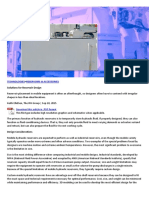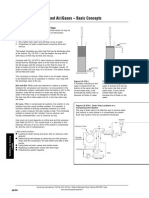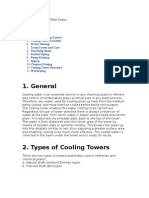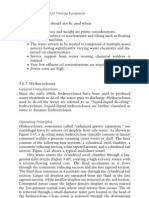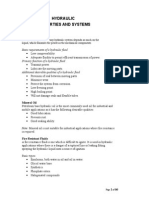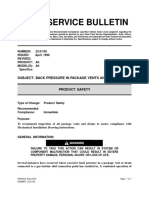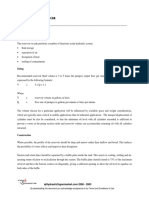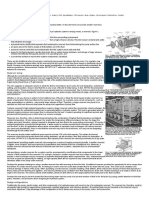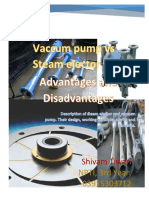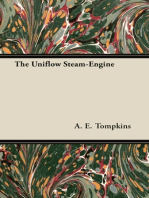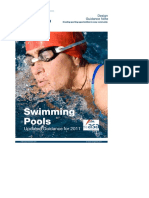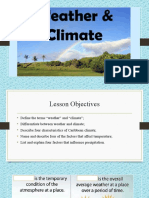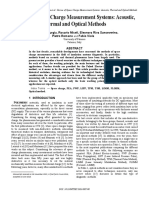Ijett V39P245
Ijett V39P245
Uploaded by
Mawada RashedCopyright:
Available Formats
Ijett V39P245
Ijett V39P245
Uploaded by
Mawada RashedOriginal Title
Copyright
Available Formats
Share this document
Did you find this document useful?
Is this content inappropriate?
Copyright:
Available Formats
Ijett V39P245
Ijett V39P245
Uploaded by
Mawada RashedCopyright:
Available Formats
International Journal of Engineering Trends and Technology (IJETT) – Volume 39 Number 5- September 2016
Study on the Basic Components of Hydraulic
Systems
Syed Mufeez Ahmed #1
#1
PG Scholar, Department of Mechanical Engineering, Bangalore, Karnataka, India.
Abstract— A hydraulic system contains and confines a material from being taken into the system. These
liquid in such a way that it uses the laws governing reservoirs are used widely used in hydraulic systems
liquids to transmit power and do work. This paper due to their high reliability and ability to work under
describes some basic systems and discusses extreme conditions[2].
components of a hydraulic system that store and 2) Pressurized Reservoir. A pressurized
condition the fluid. The oil reservoir (sump or tank) reservoir is sealed from the atmosphere. This reservoir
usually serves as a storehouse and a fluid conditioner. is pressurized either by engine bleed air or by
Filters, strainers and magnetic plugs condition the hydraulic pressure produced within the hydraulic
fluid by removing harmful impurities that could clog system itself. Pressurized reservoirs are used on
passages and damage parts. Heat exchanges or aircraft intended for high altitude flight, where
coolers often are used to keep the oil temperature atmospheric pressure is not enough to cause fluid flow
within safe limits and prevent deterioration of the oil. to the pump.
Accumulators, though technically sources of stored
energy, act as fluid storehouses.
This reservoir, or tank as it is referred to by
Boeing-Vertol, is constructed of a metal housing with
Keywords— Hydraulic systems, Reservoirs, Strainers,
two internal pistons, one fixed and the other a floating
Filters and Accumulators.
piston which slides along a central tube. Attached to
I. HYDRAULIC RESERVOIRS the floating piston is a larger tube that projects through
the forward end of the tank and is calibrated to
The hydraulic reservoir is a container for holding the indicate FULL and REFILL fluid levels for ramp-up
fluid required to supply the system, including a and ramp-down positions[3].
reserve to cover any losses from minor leakage and
evaporation. The reservoir can be designed to provide
space for fluid expansion, permit air entrained in the
fluid to escape, and to help cool the fluid. Figure 1-1
shows two typical reservoirs. Compare the two
reservoirs item by item and, except for the filters and
bypass valve, notice the similarities. Filling reservoirs
to the top during servicing leaves no space for
expansion. Most reservoirs are designed with the rim
at the filler neck below the top of the reservoir to
prevent overfilling. Some means of checking the fluid
level is usually provided on a reservoir[1]. This may
be a glass or plastic sight gage, a tube, or a dipstick.
Hydraulic reservoirs are either vented to the
atmosphere or closed to the atmosphere and
pressurized. A reservoir stores a liquid that is not
being used in a hydraulic system. It also allows gases
to expel and foreign matter to settle out from a liquid.
A description of each type follows. Figure 1
1) Vented Reservoir. A vented reservoir is one a. Construction. A properly constructed reservoir
that is open to atmospheric pressure through a vent should be able to dissipate heat from the oil, separate
line. Because atmospheric pressure and gravity are the air from the oil, and settle out contaminates that are
forces which cause the fluid to flow to the pump, a in it. Reservoirs range in construction from small
vented reservoir is mounted at the highest point in the steel stampings to large cast or fabricated units. The
hydraulic system. Air is drawn into and exhausted large tanks should be sandblasted after all the
from the reservoir through a vent line. A filter is welding is completed and then flushed and steam
usually installed in the vent line to prevent foreign cleaned[2]. Doing sore moves welding scale and
ISSN: 2231-5381 http://www.ijettjournal.org Page 268
International Journal of Engineering Trends and Technology (IJETT) – Volume 39 Number 5- September 2016
scale left from hot-rolling the steel. The inner surface pressure-control valve rather than a vented one[1]. A
then should be sealed with a paint compatible with pressure-control valve automatically lets filtered air
the hydraulic fluid. Non bleeding red engine enamel into a tank but prevents air release unless the pressure
is suitable for petroleum oil and seals in any residual reaches a preset level. A pressurized reservoir takes
dirt not removed by flushing and steam cleaning. place when the oil and air in a tank expand from heat.
b. Shape. Some of the design features of a reservoir.
It should be high and narrow rather than shallow and f. Line Connections. A pump suction and a tank's
broad. The oil level should be as high as possible return lines should be attached by flanges or by
above the opening to a pump's suction line. This welded heavy-duty couplings. Standard couplings
prevents the vacuum at the line opening from causing usually are not suitable because they spread when
a vortex or whirlpool effect, which would mean that a welded. If a suction line is connected at the bottom, a
system is probably taking in air. Aerated oil will not coupling should extend well above the bottom, inside
properly transmit power because air is the tank; residual dirt will not get in a suction line
compressible[3]. Aerated oil has a tendency to break when a tank or strainer is cleaned. A return line should
down and lose its lubricating ability. discharge near a tank's bottom, always below the oil
level. A pipe is usually cut at a 45-degree angle and
c. Size. Reservoir sizes will vary. However, a the flow aimed away from a suction line to improve
circulation and cooling. A baffle plate is used to
reservoir must be large enough so that it has a reserve
separate a suction line from a return line. This causes
of oil with all the cylinders in a system fully the return oil to circulate around an outer wall for
extended. An oil reserve must be high enough to cooling before it gets to the pump again. A baffle plate
prevent a vortex at the suction line's opening. A should be about two-thirds the height of a tank. The
reservoir must have sufficient space to hold all the oil lower corners are cut diagonally to allow
when the cylinders are retracted, as well as allow circulation[5]. They must be larger in area than a
space for expansion when the oil is hot. A common- suction line's cross section. Otherwise the oil level
size reservoir on a mobile machine is a 20- or 30- between a return and a suction side might be uneven.
gallon tank used with a 100-GPM system. Many 10- Baffling also prevents oil from sloshing around when
GPM systems operate with 2- or 3-gallon tanks a machine is moving. Many large reservoirs are cross-
because these mobile systems operate intermittently, baffled to provide cooling and prevent sloshing.
not constantly. For stationary machinery, a rule of
g. Maintenance. Maintenance procedures include
thumb is that a reservoir's size should be two to three
draining and cleaning a reservoir. A tank should have
times a pump's output per minute[2]. A large-size
a dished bottom that is fitted with a drain plug at its
tank is highly desirable for cooling. The large surface lowest point; a plug fitting should be flush with the
areas exposed to the outside air transfer heat from the inside of a tank to allow for full drainage. On large
oil. Also, a large tank helps settle out the tanks, access plates may be bolted on the ends for easy
contaminates and separates the air by reducing removal and servicing. A reservoir should have a sight
recirculation. gauge or dipstick for checking the oil level to prevent
damage from lubrication loss[4]. The strainers on a
d. Location. Most mobile equipment reservoirs are pump's suction line may not require as much
located above the pumps. This creates a flooded- maintenance. However, an element in a filter in a
pump-inlet condition. This condition reduces the return line will require regular changing. Therefore,
possibility of pump cavitations-a condition where all that filter should not be inside a reservoir. When a
the available space is not filled and often metal parts reservoir is pressurized by compressed air, moisture
will erode. Flooding the inlet also reduces the vortex can become a maintenance problem. A tank should
tendency at a suction pipe's opening. A reservoir's have a water trap for moisture removal; it should be
location affects heat dissipation. Ideally, all tank placed where it can be inspected daily.
walls should be exposed to the outside air. Heat
moves from a hot substance to a cold substance; heat II. STRAINERS AND FILTERS
transfer is greatest when there is a large temperature
difference[3]. Reservoirs that are built into front-end To keep hydraulic components performing correctly,
loader arms are very effective in transferring heat. the hydraulic liquid must be kept as clean as possible.
Foreign matter and tiny metal particles from normal
e. Ventilation. Most reservoirs are vented to the wear of valves, pumps, and other components are
atmosphere. A vent opening allows air to leave or going to enter a system. Strainers, filters, and
enter the space above the oil as the level of the oil magnetic plugs are used to remove foreign particles
goes up or down. This maintains a constant from a hydraulic liquid and are effective as safeguards
atmospheric pressure above the oil. A reservoir filter against contamination. Magnetic plugs, located in a
cap, with a filter element, is often used as a vent. reservoir, are used to remove the iron or steel particles
Some reservoirs are pressurized, using a simple from a liquid.
ISSN: 2231-5381 http://www.ijettjournal.org Page 269
International Journal of Engineering Trends and Technology (IJETT) – Volume 39 Number 5- September 2016
difference in pressure of a fluid as it enters a filter and
a. Strainers. A strainer is the primary filtering system after it leaves an element. When contaminating
that removes large particles of foreign matter from a particles collect on the element, the differential
hydraulic liquid. Even though its screening action is pressure across it increases. When a pressure increase
not as good as a filter's, a strainer offers less resistance reaches a specific value, an indicator pops out,
to flow. A strainer usually consists of a metal frame signifying that the element must be cleaned or
wrapped with a fine-mesh wire screen or a screening replaced[5]. This filter operates on the venturi
element made up of varying thicknesses of specially principle in which a tube has a narrowing throat
processed wire. If one strainer causes excessive flow
(venturi) to increase the velocity of fluid flowing
friction to a pump, two or more can be used in
through it. Flow through a venturi throat causes a
parallel. Strainers and pipe fittings must always be
below the liquid level in the tank[4]. pressure drop at the narrowest point. This pressure
b. Filters. A filter removes small foreign particles decrease causes a sucking action that draws a portion
from a hydraulic fluid and is most effective as a of a liquid down around a cartridge through a filter
safeguard against contaminants. Filters are located in a element and up into a venturi throat. Filtering occurs
reservoir, a pressure line, a return line, or in any other for either flow direction.
location where necessary. They are classified as full
flow or proportional flow. Figure 2 in a full-flow filter, III. ACCUMULATORS
all the fluid entering a unit passes through a filtering
element. Although a full-flow type provides a more Like an electrical storage battery, a hydraulic
positive filtering action, it offers greater resistance to accumulator stores potential power, in this case
flow, particularly when it becomes dirty. A hydraulic liquid under pressure, for future conversion into
liquid enters a full-flow filter through an inlet port in useful work. This work can include operating
the body and flows around an element inside a bowl. cylinders and fluid motors, maintaining the required
Filtering occurs as a liquid passes through the element system pressure in case of pump or power failure,
and into a hollow core, leaving the dirt and impurities and compensating for pressure loss due to leakage.
on the outside of the element[2]. A filtered liquid then Accumulators can be employed as fluid dispensers
flows from a hollow core to an outlet port and into the and fluid barriers and can provide a shock-
system. absorbing (cushioning) action. Accumulators are
used mainly on the lift equipment to provide
positive clamping action on the heavy loads when a
pump's flow is diverted to lifting or other
operations. An accumulator acts as a safety device
to prevent a load from being dropped in case of an
engine or pump failure or fluid leak[3]. On lifts and
other equipment, accumulators absorb shock, which
results from a load starting, stopping, or reversal.
a. Spring-Loaded Accumulator. This accumulator is
used in some engineer equipment hydraulic systems. It
uses the energy stored in springs to create a constant
force on the liquid contained in an adjacent ram
assembly. Figure 3 shows two spring-loaded
accumulators. The load characteristics of a spring are
such that the energy storage depends on the force
required to compress a spring. The free
(uncompressed) length of a spring represents zero
energy storage. As a spring is compressed to the
maximum installed length, a minimum pressure value
of the liquid in a ram assembly is established. As
liquid under pressure enters the ram cylinder, causing
a spring to compress, the pressure on the liquid will
rise because of the increased loading required to
Figure 2 compress the spring.
A bypass relief valve in a body allows a liquid to
bypass the element and pass directly through an outlet
port when the element becomes clogged. Filters that
do not have a bypass relief valve have a contamination
indicator. This indicator works on the principle of the
ISSN: 2231-5381 http://www.ijettjournal.org Page 270
International Journal of Engineering Trends and Technology (IJETT) – Volume 39 Number 5- September 2016
c. Piston-Type Accumulator. This accumulator
consists of a cylinder assembly, a piston assembly,
and two end-cap assemblies. The cylinder assembly
houses a piston assembly and incorporates provisions
for securing the end-cap assemblies. An accumulator
contains a free-floating piston with liquid on one side
of the piston and precharged air or nitrogen on the
other side Figure 5. An increase of liquid volume
decreases the gas volume and increases gas pressure,
which provides a work potential when the liquid is
allowed to discharge. The piston accumulator serves
the same purpose and operates by the same principles
as do the diaphragm and bladder accumulators. As
fluid pressure from the system enters the left port,
forcing the piston down against the initial air charge in
the right chamber of the cylinder. A high-pressure air
valve is located at the right port for charging the unit.
Figure 3 A drilled passage from the fluid side of the piston to
b. Bag-Type Accumulator. This accumulator Figure the outside of the piston provides lubrication between
4 consists of a seamless, high-pressure shell, the cylinder walls and the piston.
cylindrical in shape, with domed ends and a synthetic
rubber bag that separates the liquid and gas (usually
nitrogen) within the accumulator. The bag is fully
enclosed in the upper end of a shell. The gas system
contains a high-pressure gas valve. The bottom end of
the shell is sealed with a special plug assembly
containing a liquid port and a safety feature that makes
it impossible to disassemble the accumulator with
pressure in the system. The bag is larger at the top and
tapers to a smaller diameter at the bottom. As the
pump forces liquid into the accumulator shell, the
liquid presses against the bag, reduces its volume, and
increases the pressure, which is then available to do
work[5].
Figure 5
d. Diaphragm Accumulator. The diaphragm
accumulator consists of two hollow, hemispherical
metal sections bolted together at the center. Notice in
Figure 6 that one of the halves has a fitting to attach
the unit to the hydraulic system; the other half is
equipped with an air valve for charging the unit with
compressed air or nitrogen. Mounted between the two
halves is a synthetic rubber diaphragm that divides the
accumulator into two sections. The accumulator is
initially charged with air through the air valve to a
pressure of approximately 50 percent of the hydraulic
system pressure[2]. This initial air charge forces the
diaphragm upward against the inner surface of the
upper section of the accumulator. When fluid pressure
increases above the initial air charge, fluid is forced
into the upper chamber through the system pressure
port, pushing the diaphragm down and further
compressing the air in the bottom chamber. Under
peak load, the air pressure in the lower chamber forces
fluid back into the hydraulic system to maintain
operating pressure. Also, if the power pump fails, the
Figure 4 compressed air forces a limited amount of pressurized
ISSN: 2231-5381 http://www.ijettjournal.org Page 271
International Journal of Engineering Trends and Technology (IJETT) – Volume 39 Number 5- September 2016
fluid into the system.
Figure 6
IV. PRESSURE GAUGES.
Pressure gauges are used in liquid-powered systems to Figure 7
measure pressure to maintain efficient and safe
operating levels. Pressure is measured in psi. Flow V. HYDRAULIC MOTORS
measurement may be expressed in units of rate of
flow-GPM or cubic feet per second (cfs). It may also Hydraulic motors are installed in hydraulic systems to
be expressed in terms of total quantity-gallons or cubic use hydraulic pressure in obtaining powered rotation.
feet. Gauge readings indicate the fluid pressure set up A hydraulic motor does just the opposite of what a
by an opposition of forces within a system. power -driven pump does. A pump receives rotative
Atmospheric pressure is negligible because its action force from an engine or other driving unit and
at one place is balanced by its equal action at another converts it into hydraulic pressure. A hydraulic motor
place in a system. flow depends on the quantities, flow receives hydraulic fluid pressure and converts it into
rates, and types of liquid involved[4]. All liquid meters
rotative force. Figure 8 shows a typical hydraulic
(flow meters) are made to measure specific liquids and
motor. The two main ports through which fluid
must be used only for the purpose for which they were
pressure is received and return fluid is discharged are
made. Each meter is tested and calibrated. In a
nutating-piston-disc flow meter, liquid passes through marked A and B, respectively[5]. The motor has a
a fixed-volume measuring chamber, which is divided cylinder block-and-piston assembly in which the bores
into upper and lower compartments by a piston disc. and pistons are in axial arrangement, the same as in a
During operation, one compartment is continually hydraulic pump. Hydraulic motors can be instantly
being filled while the other is being emptied. As a started, stopped, or reversed under any degree of load;
liquid passes through these compartments, its pressure they can be stalled by overload without damage. The
causes a piston disc to roll around in the chamber. The direction of rotation of a hydraulic motor can be
disc's movements operate a dial (or counter) through changed by reversing the flow of fluid into the ports of
gearing elements to indicate that a column of fluid that the motor.
has passed through the meter.
Figure 8
ISSN: 2231-5381 http://www.ijettjournal.org Page 272
International Journal of Engineering Trends and Technology (IJETT) – Volume 39 Number 5- September 2016
ACKNOWLEDGEMENT
My special thanks to Management & Staff of M/s
XYZ Limited, who have helped me to complete this
Practical Exercise and have shared their process
knowledge. I Am Grateful of SM Mustaq, Professor,
Department of Mechanical Engineering, for setting up
a Shop Floor exercise as a part of my studies and gain
the maximum of insight. At last not the least, am
Grateful of my family for their unrelenting patronage
& support.
REFERENCES
[1] Text book of Hydraulics by H. Meixner and R.Kober, Edn.
1990 published by FIESTO DIDACTIC KG, D – 7300
Esslingen, 1977, 1988.
[2] Basics for the Fluid Power Mechanic. Greg P Gordon, Ohio
University
[3] Fluid Power System Dynamics. William Durfee, Dept of
Mechanical Engineering, University of Minnesota
[4] Fluid Power Transmission and Control, Khalid Hussain Syed,
Charotar Publication House, 2007. Pg 165-166.
[5] Fluid Power - Hydraulics and Pneumatics. James R Dianes,
Goodheart Willcox Co, ISBN- 1605250813.
ISSN: 2231-5381 http://www.ijettjournal.org Page 273
You might also like
- Corrosion Basics - An Introduction, 3rd EditionDocument35 pagesCorrosion Basics - An Introduction, 3rd Editioncarlos100% (1)
- SUG 102 TheoryDocument80 pagesSUG 102 TheoryVietHungCao80% (10)
- Oil and Gas Artificial Fluid Lifting TechniquesFrom EverandOil and Gas Artificial Fluid Lifting TechniquesRating: 5 out of 5 stars5/5 (1)
- A Review of Barker's Activity Coefficient Method and VLE Data ReductionDocument7 pagesA Review of Barker's Activity Coefficient Method and VLE Data Reductionmurdanetap957No ratings yet
- Hydraulic Reservoirs For Mobile Equipment 7-18-14Document9 pagesHydraulic Reservoirs For Mobile Equipment 7-18-14mulle2002No ratings yet
- Fundamentals of HydraulicsDocument101 pagesFundamentals of HydraulicsLuis Nunes100% (1)
- HydraulicsDocument8 pagesHydraulicsShaddy GitauNo ratings yet
- Basics of Hydralic SystemDocument101 pagesBasics of Hydralic SystemNikhil MalhotraNo ratings yet
- Solutions For Reservoir DesignDocument7 pagesSolutions For Reservoir DesignSympatyagaNo ratings yet
- Fundamentals of HydraulicsDocument101 pagesFundamentals of HydraulicswissamhijaziNo ratings yet
- Reservoirs, Strainers and FiltersDocument16 pagesReservoirs, Strainers and FiltersMohan CharanchathNo ratings yet
- Variable Volume ReservoirDocument6 pagesVariable Volume ReservoirSympatyagaNo ratings yet
- Storage Tank and Pressure Vessel Design-Written..Document16 pagesStorage Tank and Pressure Vessel Design-Written..Angelica de Torres100% (4)
- AccumulatorDocument5 pagesAccumulatorMohan CharanchathNo ratings yet
- 5 6339170067296551364Document162 pages5 6339170067296551364Helna joseph JOSENo ratings yet
- Battery Production - Pressurized VesselsDocument12 pagesBattery Production - Pressurized VesselsEmi BarreraNo ratings yet
- 07 Compressed Air SolutionsDocument36 pages07 Compressed Air Solutionsvlcmstne04No ratings yet
- Powerpack MaintenanceDocument24 pagesPowerpack MaintenanceSai Ganesh Techno SolutionNo ratings yet
- Experiment No. 2 Hydraulic Power PackDocument52 pagesExperiment No. 2 Hydraulic Power PacksbkulkNo ratings yet
- Mechanical Pumps For Vacuum ProcessingDocument10 pagesMechanical Pumps For Vacuum Processinghwang2No ratings yet
- Volume-4. Study To Hydraulic AccessoriesDocument67 pagesVolume-4. Study To Hydraulic AccessoriesQ.S. Khan91% (11)
- Installation, Commissioning and Maintenance Guidelines: For Electrohydraulic SystemsDocument0 pagesInstallation, Commissioning and Maintenance Guidelines: For Electrohydraulic Systemsanta77100% (1)
- 5 Hydraulic ReservoirsDocument3 pages5 Hydraulic ReservoirsMohamed SokarNo ratings yet
- Plant Layout - Cooling Water TowersDocument7 pagesPlant Layout - Cooling Water TowersSouparna DuttaNo ratings yet
- Tex Leugner Hydraulic TroubleshootingDocument29 pagesTex Leugner Hydraulic TroubleshootingMehmet ErbekNo ratings yet
- Refrigeration Laboratory Manual 2011Document19 pagesRefrigeration Laboratory Manual 2011Himanshu Uniyal0% (1)
- Air Cleaners and ManfoldsDocument20 pagesAir Cleaners and Manfoldscollins arogoNo ratings yet
- Hydro CyclonesDocument9 pagesHydro CyclonesBambang HadinugrohoNo ratings yet
- VOL.4. Hydraulic AccessoriesDocument67 pagesVOL.4. Hydraulic AccessoriesQ.S.Khan100% (2)
- Basic HydraulicDocument66 pagesBasic HydraulicKamil Ikram100% (1)
- What Are Reboiler TypesDocument4 pagesWhat Are Reboiler TypesRizwan FaridNo ratings yet
- DsairelimDocument10 pagesDsairelimGerman Felipe TorresNo ratings yet
- Best Practice Guide For Power Transformer Maintenance EEPDocument1 pageBest Practice Guide For Power Transformer Maintenance EEPashutosh ambeyNo ratings yet
- TurbochargerDocument8 pagesTurbochargersudheeshNo ratings yet
- Hydraulics and Pneumatics - Components-1Document179 pagesHydraulics and Pneumatics - Components-1edmondkalinde33No ratings yet
- Treaters SeparatorDocument6 pagesTreaters SeparatorDayo IdowuNo ratings yet
- Auxiliary Marine Machinery: Under ConstructionDocument55 pagesAuxiliary Marine Machinery: Under ConstructionAkpojosevbe SamuelNo ratings yet
- Auxiliary Marine Machinery: Under ConstructionDocument55 pagesAuxiliary Marine Machinery: Under ConstructionArunNo ratings yet
- Auxiliary Marine Machinery: Under ConstructionDocument55 pagesAuxiliary Marine Machinery: Under ConstructionAbhinav100% (1)
- 22 0 100 - NCDocument7 pages22 0 100 - NCjussmeeeNo ratings yet
- Reservatórios HidráulicosDocument2 pagesReservatórios HidráulicosMateus EugênioNo ratings yet
- Variable Volume ReservoirDocument3 pagesVariable Volume ReservoirVelibor KaranovicNo ratings yet
- Stern Tubes: Water Lubricated BearingsDocument11 pagesStern Tubes: Water Lubricated BearingsMurugappan ChandrasekaranNo ratings yet
- Recip. Comp ECDPDocument51 pagesRecip. Comp ECDPSkydriver Paul100% (1)
- Fluid Power Design Data SheetDocument2 pagesFluid Power Design Data SheetMayuresh MahajanNo ratings yet
- NPTI, 3rd Year, 03915303712: Shivam TiwariDocument6 pagesNPTI, 3rd Year, 03915303712: Shivam Tiwarishashi kant kumarNo ratings yet
- NPTI, 3rd Year, 03915303712: Shivam TiwariDocument6 pagesNPTI, 3rd Year, 03915303712: Shivam TiwariMantuomNo ratings yet
- Technická Univerzita V Košiciach: Letecká FakultaDocument18 pagesTechnická Univerzita V Košiciach: Letecká FakultaAdika StadevantNo ratings yet
- 3.1 - ScavengingDocument6 pages3.1 - ScavengingPrafull TripathiNo ratings yet
- Petro Unit 2-IDocument77 pagesPetro Unit 2-INawal AgarwalNo ratings yet
- Reciprocating CompressorsDocument4 pagesReciprocating CompressorsRoyalAryans100% (2)
- Reciprocating Compressor BasicsDocument5 pagesReciprocating Compressor BasicsJose Luis RattiaNo ratings yet
- Hydraulic Systems: Comprehension Report-3Document10 pagesHydraulic Systems: Comprehension Report-3sathesh waranNo ratings yet
- Design of Petroleum Refining Equipment-1Document20 pagesDesign of Petroleum Refining Equipment-1sherifelbayoumy266No ratings yet
- Petroleum Production Engineering Boyun GuoDocument15 pagesPetroleum Production Engineering Boyun GuoDiandra Aullia100% (1)
- Maintenance of TRansformer 1 PDFDocument20 pagesMaintenance of TRansformer 1 PDFVinoth Stratumpc100% (1)
- Types of Valves in Piping: Types of Valves - Tables to estimate man hours of assemblyFrom EverandTypes of Valves in Piping: Types of Valves - Tables to estimate man hours of assemblyNo ratings yet
- Practical Rules for the Management of a Locomotive Engine in the Station, on the Road, and in cases of AccidentFrom EverandPractical Rules for the Management of a Locomotive Engine in the Station, on the Road, and in cases of AccidentNo ratings yet
- GEC223 - The Boundary Layer Is A Consequence of The Stickiness of The FluidDocument12 pagesGEC223 - The Boundary Layer Is A Consequence of The Stickiness of The FluidMawada RashedNo ratings yet
- Eng Daisy GirlDocument12 pagesEng Daisy GirlMawada Rashed100% (3)
- Guidelines Swimming - PoolDocument16 pagesGuidelines Swimming - PoolMawada RashedNo ratings yet
- Hydraulics in Civil and Environmental enDocument2 pagesHydraulics in Civil and Environmental enMawada RashedNo ratings yet
- Qdoc - Tips - Swimming Pools Design 2011 Rev3pdfDocument97 pagesQdoc - Tips - Swimming Pools Design 2011 Rev3pdfMawada RashedNo ratings yet
- Part II B BMP MOP Combined 6-24-19Document227 pagesPart II B BMP MOP Combined 6-24-19Mawada RashedNo ratings yet
- Class 2 Physical Properties of Hydraulic FluidsDocument31 pagesClass 2 Physical Properties of Hydraulic FluidsMawada RashedNo ratings yet
- Nozzles Data-SheetDocument9 pagesNozzles Data-SheetMawada RashedNo ratings yet
- Pool Disinfection and Breakpoint ChlorinationDocument6 pagesPool Disinfection and Breakpoint ChlorinationMawada RashedNo ratings yet
- Factsheet605 Domestic+swimming+pools+water+care June2013Document3 pagesFactsheet605 Domestic+swimming+pools+water+care June2013Mawada RashedNo ratings yet
- Formation of Disinfection By-Products in The Swimming Pool Water Treated With Different Disinfection TypesDocument8 pagesFormation of Disinfection By-Products in The Swimming Pool Water Treated With Different Disinfection TypesMawada RashedNo ratings yet
- 10 ELS Final Module 10 08082020Document26 pages10 ELS Final Module 10 08082020jeseca cincoNo ratings yet
- MDPN372 PS2 Spring 2021Document3 pagesMDPN372 PS2 Spring 2021akhbar elyoum academyNo ratings yet
- ETABSDocument9 pagesETABSZabihullah SafiNo ratings yet
- A530a530m PDFDocument8 pagesA530a530m PDFrodrigoNo ratings yet
- Creep Design PDFDocument4 pagesCreep Design PDFSugumar SNo ratings yet
- The Hydrogen Spectrum and The Bohr ModelDocument13 pagesThe Hydrogen Spectrum and The Bohr Modeljuso_jusicNo ratings yet
- Effect of Hydrocolloids On The Properties of Wheat Potato Starch MixturesDocument9 pagesEffect of Hydrocolloids On The Properties of Wheat Potato Starch MixturesReaganKawumaNo ratings yet
- Venturimeter 1Document4 pagesVenturimeter 1Rkrishna ANo ratings yet
- HW04 255Document3 pagesHW04 255Thomas BaahNo ratings yet
- AlfaLaval Heat Transfer TheoryDocument15 pagesAlfaLaval Heat Transfer TheoryAndrés Ramón Linares100% (3)
- Discussion, Explaintatition Dan ReviewDocument19 pagesDiscussion, Explaintatition Dan ReviewFadlan BarcelonistanNo ratings yet
- Weather and ClimateDocument17 pagesWeather and ClimateDylan HelpsNo ratings yet
- Exciton Comsol Yao - PresentationDocument13 pagesExciton Comsol Yao - Presentationhhakim32No ratings yet
- Chemical Process DynamicsDocument3 pagesChemical Process DynamicsAnurag SrivastavaNo ratings yet
- LUBExpert & Vibration Analysis Case StudyDocument4 pagesLUBExpert & Vibration Analysis Case StudyfimybdwpfavhtgpaenNo ratings yet
- GUIDELINEFORFIELDTESTINGOFGASTURBINEANDCENTRIFUGALCOMPRESSORPERFORMANCEDocument94 pagesGUIDELINEFORFIELDTESTINGOFGASTURBINEANDCENTRIFUGALCOMPRESSORPERFORMANCERaba'i Yahaya100% (1)
- Precision Grouting of TurbomachineryDocument16 pagesPrecision Grouting of TurbomachineryReyes SanchezNo ratings yet
- Review of Space Charge Measurement SystemsDocument17 pagesReview of Space Charge Measurement SystemsSatayish AnjumNo ratings yet
- Calculation of Δ0, Inter Electronic Repulsion Parameter (B) & β for d1, d9, d4, d6, d2 & d8 ComplexesDocument32 pagesCalculation of Δ0, Inter Electronic Repulsion Parameter (B) & β for d1, d9, d4, d6, d2 & d8 Complexesramukaka100% (3)
- Use of The TephigramDocument16 pagesUse of The TephigramCyclone warning centre VisakhapatnamNo ratings yet
- Gaggia Classic Performance TestDocument2 pagesGaggia Classic Performance TestKanen Coffee, LLC.No ratings yet
- Information On Belt Selection and Storage: Reporting Reference: LBT-CP031204Document8 pagesInformation On Belt Selection and Storage: Reporting Reference: LBT-CP031204haziqNo ratings yet
- B.Tech Mech - 18-19 - PTDocument118 pagesB.Tech Mech - 18-19 - PTM Jeevitha Vijay SankarNo ratings yet
- Moleaer XTB Data SheetDocument2 pagesMoleaer XTB Data Sheetsd0058No ratings yet
- Fourier's Law and The Heat Equation: Chapter TwoDocument18 pagesFourier's Law and The Heat Equation: Chapter TwoAnonymous 3H9KhhDONo ratings yet
- Geo Weather Quiz Notes1Document3 pagesGeo Weather Quiz Notes1Michelle LiNo ratings yet
- Booster Pump Head Loss CalculationDocument6 pagesBooster Pump Head Loss CalculationshoaibNo ratings yet








